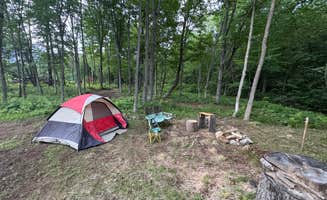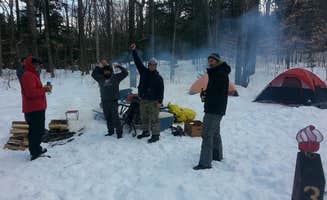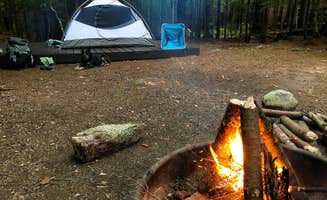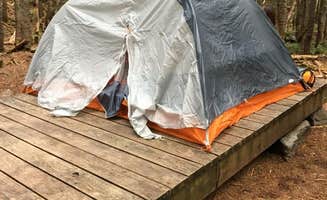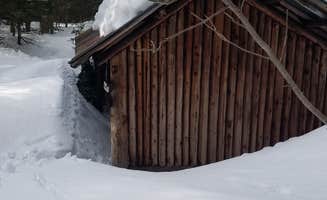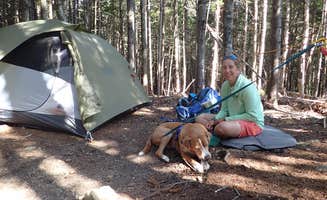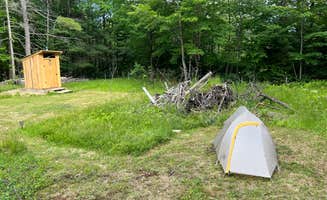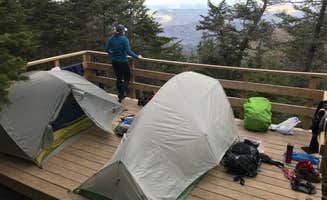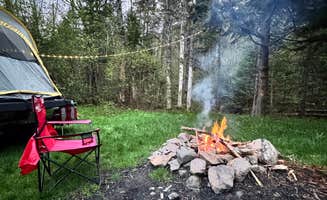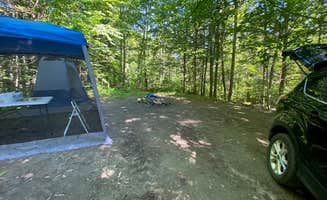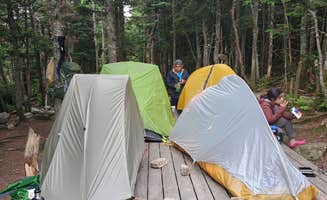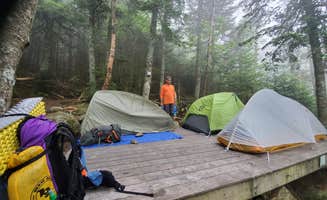Tent camping in White Mountain National Forest surrounds Glen, New Hampshire with primitive sites at elevations ranging from 800 to 3,500 feet. Campers can access numerous backcountry locations via trails connecting to both the Kancamagus Highway and Route 302. Most primitive sites require hiking between a quarter mile to 5 miles depending on the trailhead.
What to do
Swimming in natural spots: Fourth Iron Campground offers excellent water access along the Saco River. "The water is clear and cold, refreshing on a warm day," notes Sarah C. Sites feature "multiple rocky beaches in between the sites and river" where campers can cool off during summer months.
Hiking to waterfalls: When staying near Crawford Notch, use Fourth Iron as a base for nearby waterfall hikes. "Near some short waterfall hikes," reports Mike M., making it convenient for day adventures without breaking camp. The parking area is just off Highway 302 between Bartlett and Crawford Notch.
Winter adventures: Experience cold-weather camping at Sawyer Pond. "Probably one of my favorite nights out, stayed in the open air shelter. No one else was there. Waist deep snow made hike in a little more difficult, post holing every 5th step," shares Ryan M. Winter camping requires specialized gear but rewards with solitude.
What campers like
Stargazing opportunities: The best tent camping near Glen, New Hampshire includes sites with minimal light pollution. Campers at Sawyer Pond report exceptional night skies. "The stars were AMAZING. I've never seen stars like I did here, all around the pond. They took my breath away!" writes Erin H.
Bear safety systems: Guyot Shelter provides excellent food storage options for backcountry campers. "This is a very large campground. With a large shelter renovated in 2019... X3 bear boxes," reports Jerome S. The bear boxes are located in a communal eating area, making food storage convenient while maintaining safety.
Reliable water sources: Most tent sites near Glen require water filtration, but campers appreciate dependable sources. At Guyot Shelter, visitors note "Great Water source right near the eating area." The spring water runs consistently throughout most seasons, though treatment remains necessary.
What you should know
Train noise considerations: Some riverside camping areas have nearby active rail lines. At Fourth Iron Campground, "You will cross train tracks to reach the campground and they are active tracks, so you'll hear trains," warns Jean C. The trade-off for riverside camping includes occasional train disturbances.
Site layout peculiarities: Certain campgrounds have unique site arrangements that affect privacy. "Sites 1 and 2 are situated one behind the other so you have to walk through one site to get to the other," explains Sarah C. about Fourth Iron. Similarly, at Nauman Tentsite, platforms have varying degrees of seclusion.
Seasonal popularity timing: During peak summer months, arrive early to secure spots. Hunter P. advises about Sawyer Pond: "I visited this campsite on a Sunday night in September with my dog and it was lovely. I passed a few day hikers but was the only person camping, however I did speak to a family that was hiking down who said that the campground was completely full the night before (Saturday night)."
Tips for camping with families
Beginner-friendly backpacking: Choose easier access sites for first family adventures. "This is a great beginner backpacking trip, great even for kids! The site has one shelter and 6 campsites available on the bank of Sawyer Pond," notes Sarah C. The 1.5-mile approach from the trailhead makes it manageable for children.
Kid-friendly water features: Northern Nursery Brookside Campsites offers 15 tent sites along a stream with easy access. "There are 15 tent sites along the water, and a quick walk from the parking area," describes Jake C., making water play accessible for families with young children.
Wildlife viewing opportunities: Children often enjoy spotting wildlife near camp. At Hermit Lake Shelters, "The lake is pretty, and there is tons of wildlife around, from birds to red squirrels to moose, who often go for a dip in the lake," according to Sable W., creating natural education opportunities.
Tips for RVers
Park-and-hike strategies: While most tent sites near Glen require hiking, RVers can use designated parking areas as base camps. At Sawyer Pond, "The trail head is located at the end of a 9 mile road and there are several spots for parking," notes Hunter P. RVers should be aware that "there is no cell service once you get on this road."
Supply staging for backpacking: Fourth Iron's parking area works well for RVers transitioning to tent camping. "I would suggest packing in a manner that allows you to get your things from your car to the site easily and with the fewest trips possible," recommends Sarah C. Organize gear at your RV before hiking to the campsite.
Seasonal road closures: RVers should check road status before attempting access to trailheads. For Sawyer Pond, Jean C. advises, "Check the White Mountain National Forest website for information about road openings in the spring and fall" as seasonal closures can extend hiking distances considerably.


